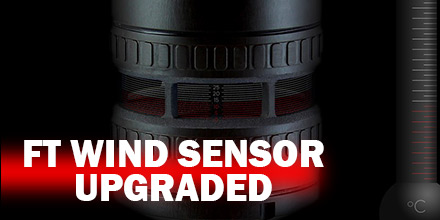
Recently, FT Technologies updated the 722 and 742 digital wind sensors.
Now, these models can read acoustic temperature as well as wind speed and wind direction.
The air temperature is derived from the operating frequency of the sensor. It has an accuracy of ±1°C.
FT742 wind sensor upgrade
Customers who currently use FT digital wind sensors for wind speed and direction measurement, can now read the air temperature. All this capability from one maintenance-free device.
The new software is available to existing users at no extra cost.
The FT742-SM model also includes an electronic compass.
How it works
FT wind sensors work by establishing a resonant, ultrasonic frequency in the measurement cavity. Sensors then measure the phase change of that ultrasonic signal as air passes through the cavity.
The resonant frequency varies with the speed of sound which itself is heavily dependent on air temperature and, to a lesser extent, relative humidity and air pressure.
Therefore, the sensor can derive the temperature of the air from the frequency of the ultrasonic signal. Hence, the name ‘acoustic temperature’.
The accuracy is affected by the temperature difference between the sensor and the cavity. This is common with all ultrasonic systems measuring acoustic temperature.
With the heater off, accuracy is ±1°C at wind speeds between 5m/s and 60m/s and at temperatures ranging from -20°C - +60°C.
Accuracy is ±2°C with the heater on.
FT sensors have no moving parts to break or degrade. As such, they are ideal for use in extreme conditions. Additionally, these sensors are great for extended operations.
About FT Technologies
FT Technologies specializes in the design and manufacture of high performance Acoustic Resonance wind sensors – also known as anemometers or air-flow sensors. All our sensors incorporate our own patented Acu-Res® Technology which enables them to deliver reliable wind speed and direction data, from compact, lightweight sensors. Users typically experience over 99.9% data availability, even in harsh climates with the toughest weather conditions.
 Recently, FT Technologies updated the 722 and 742 digital wind sensors.
Now, these models can read acoustic temperature as well as wind speed and wind direction.
The air temperature is derived from the operating frequency of the sensor. It has an accuracy of ±1°C.
Recently, FT Technologies updated the 722 and 742 digital wind sensors.
Now, these models can read acoustic temperature as well as wind speed and wind direction.
The air temperature is derived from the operating frequency of the sensor. It has an accuracy of ±1°C.

